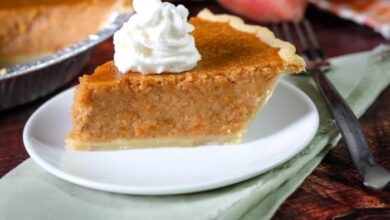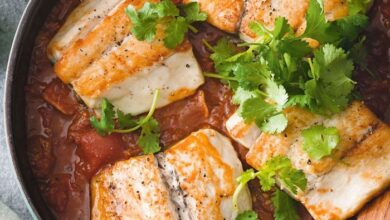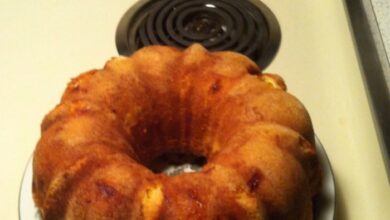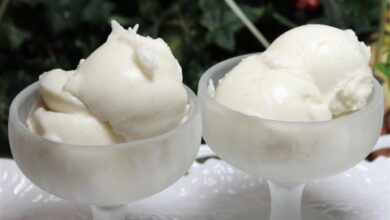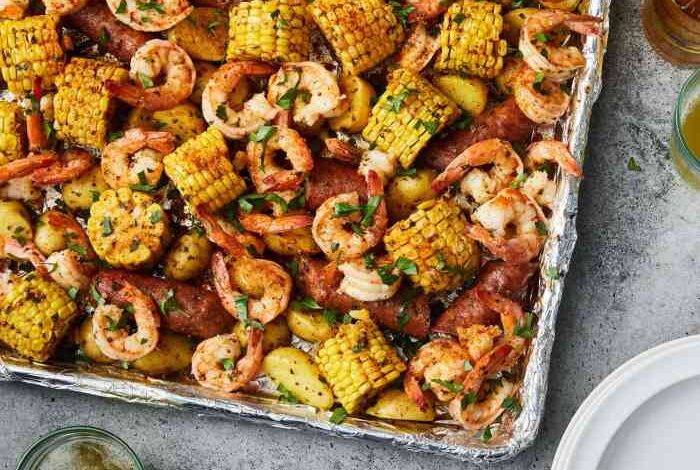
Mild Style Shrimp Boil with Corn and Red Potatoes: A Flavorful Feast
Mild Style Shrimp Boil with Corn and Red Potatoes: A Flavorful Feast is a culinary adventure that transports you to the heart of Southern comfort food. This dish is a celebration of fresh seafood, vibrant vegetables, and the perfect balance of spices.
Imagine a steaming pot filled with plump shrimp, sweet corn on the cob, and tender red potatoes, all infused with a subtle blend of seasonings that awaken your taste buds. This isn’t just a meal; it’s an experience, a gathering of friends and family around a table, sharing stories and laughter as they savor each delicious bite.
The origins of shrimp boils can be traced back to the coastal regions of the United States, where seafood was abundant and readily available. This simple yet satisfying dish quickly became a staple, passed down through generations, and adapted to local tastes and preferences.
Today, shrimp boils are enjoyed all over the world, with each region adding its own unique twist to the classic recipe. From the mild and delicate flavors of the South to the bolder spices of the Caribbean, there’s a shrimp boil out there for every palate.
Shrimp Boil: A Mildly Delicious Dive
A shrimp boil is a classic Southern dish, often enjoyed outdoors with friends and family. This flavorful and messy feast features shrimp, potatoes, corn, and a variety of seasonings cooked together in a large pot of boiling water. While the traditional shrimp boil is known for its spicy kick, a mild style caters to those who prefer a more subtle flavor profile.
Origins and Cultural Significance
Shrimp boils have a rich history, dating back to the early days of Louisiana’s Cajun and Creole cultures. These coastal communities relied heavily on seafood, and the shrimp boil emerged as a practical and delicious way to prepare a large quantity of shrimp.
The dish became a staple at family gatherings, festivals, and community events, symbolizing a shared love for seafood and a celebration of Southern traditions.
Key Ingredients and Flavors of a Mild Style Shrimp Boil
The key to a delicious mild style shrimp boil lies in carefully selecting the right ingredients and seasonings. Here’s a breakdown of the essential components:
- Shrimp:The star of the show, fresh shrimp is essential for a flavorful boil. Opt for medium or large shrimp, peeled and deveined for ease of eating.
- Potatoes:Red potatoes are the classic choice for shrimp boils, adding a hearty and slightly sweet element.
- Corn:Corn on the cob adds a touch of sweetness and texture.
- Seasonings:A mild style shrimp boil focuses on subtle flavors, typically using a blend of spices such as:
- Garlic:Adds a fragrant and savory note.
- Onion:Provides a base for the flavor profile.
- Bay leaves:Contribute a subtle earthy aroma.
- Black pepper:Adds a touch of heat without being overpowering.
- Old Bay seasoning:A popular choice for shrimp boils, offering a blend of herbs and spices that adds a unique flavor.
Recipe Variations
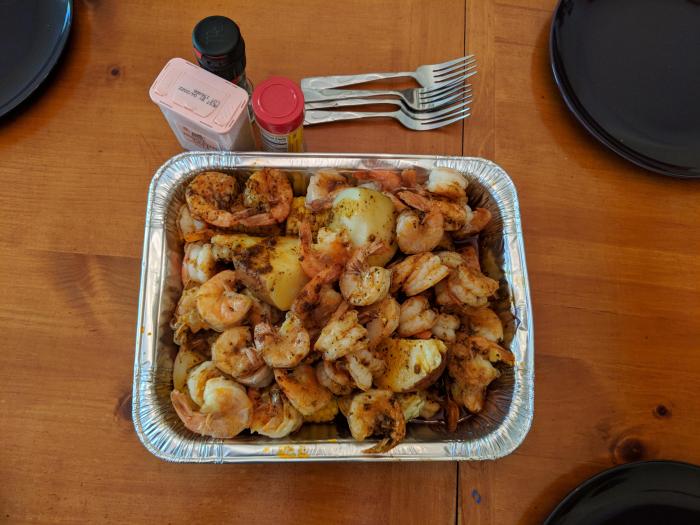
A mild shrimp boil can be customized to suit your taste preferences and dietary needs. Experimenting with different ingredients and cooking methods can result in a unique and delicious meal.
Shrimp Selection
The type of shrimp you choose can significantly impact the flavor and texture of your shrimp boil. Here are some popular choices:
- Whiteleg Shrimp:These shrimp are commonly found in the United States and are known for their mild flavor and firm texture. They are a good all-around choice for shrimp boils.
- Pink Shrimp:Pink shrimp have a slightly sweeter flavor than whiteleg shrimp and are often considered more delicate. They are a good choice if you prefer a less intense shrimp flavor.
- Tiger Shrimp:Tiger shrimp are a larger, more flavorful variety with a distinct, slightly sweet taste. They are a good choice for those who want a more robust shrimp flavor.
Spice and Seasoning
While a mild shrimp boil aims for a balanced flavor profile, spices and seasonings play a crucial role in enhancing the taste.
- Bay Leaf:This aromatic herb adds a subtle, earthy flavor to the boil.
- Black Peppercorns:These peppercorns provide a mild heat and enhance the overall flavor of the dish.
- Garlic:Fresh garlic adds a pungent aroma and flavor to the boil, complementing the shrimp and other ingredients.
- Old Bay Seasoning:This popular seasoning blend is a staple in many shrimp boils. It contains a combination of herbs and spices, including celery salt, paprika, and black pepper, creating a savory and slightly spicy flavor.
Cooking Methods
While boiling is the most traditional method for preparing a shrimp boil, other cooking methods can also be used to achieve delicious results.
- Boiling:This method is simple and efficient, allowing the shrimp and other ingredients to cook evenly in a large pot of seasoned water. It is ideal for large quantities of shrimp and vegetables.
- Steaming:Steaming is a healthier cooking method that uses steam to cook the shrimp and vegetables. It preserves the natural flavors and nutrients of the ingredients.
- Grilling:Grilling adds a smoky flavor to the shrimp and vegetables. It is a good choice for smaller quantities of shrimp and vegetables and can be used to create a more rustic and flavorful dish.
Ingredients and Preparation
A shrimp boil is a fun and flavorful dish that’s perfect for a casual gathering. This recipe uses a mild seasoning blend that’s great for those who prefer a less spicy experience. The key to a successful shrimp boil is using fresh, high-quality ingredients.
Let’s dive into the ingredients and preparation steps.
Ingredients
This section Artikels the ingredients needed for a mild shrimp boil with corn and red potatoes.
Sometimes, a simple, flavorful shrimp boil with corn and red potatoes is all you need. The sweet corn, tender potatoes, and juicy shrimp, all seasoned with a touch of Cajun spice, make for a perfect summer meal. But for a change of pace, I’ve been craving something smoky and hearty.
I’m thinking about trying out Bobby’s smoked chuck roast recipe I saw on Cerita Kuliner – it looks absolutely delicious! After that, I’ll definitely be back to my shrimp boil, though. It’s a classic for a reason.
- Shrimp:Choose 1-2 pounds of peeled and deveined medium-sized shrimp. Look for shrimp with a firm texture, a translucent appearance, and a mild, slightly sweet aroma. Avoid shrimp that have a strong fishy odor or discoloration.
- Red Potatoes:Select 1-2 pounds of red potatoes, about 1 inch in size. Red potatoes hold their shape well during cooking and provide a pleasant starchy texture. Look for potatoes that are firm to the touch, free of blemishes, and have a smooth surface.
- Corn on the Cob:Choose 4-6 ears of fresh corn. Look for corn with bright green husks and firm kernels. Avoid corn with wilted husks, discolored kernels, or any signs of mold.
- Seasoning Blend:You can create your own blend or use a store-bought seasoning mix. A mild seasoning blend typically includes:
- 1/4 cup Old Bay Seasoning
- 1 tablespoon garlic powder
- 1 tablespoon onion powder
- 1 teaspoon paprika
- 1 teaspoon black pepper
- 1 teaspoon cayenne pepper (optional, for a bit of heat)
- Water:Use enough water to cover the shrimp, potatoes, and corn in a large pot.
- Lemon:Cut a lemon into wedges to serve with the shrimp boil. Lemons add a bright and refreshing acidity that complements the flavors of the dish.
- Butter:Melt a few tablespoons of butter to drizzle over the finished shrimp boil. Butter adds a rich and creamy flavor that enhances the overall experience.
Preparation
This section provides step-by-step instructions for preparing the ingredients.
- Prepare the Shrimp:Rinse the shrimp under cold water and pat them dry with paper towels. If the shrimp are not already peeled and deveined, remove the shells and the dark vein running along the back. You can also use frozen shrimp, but thaw them completely before using.
- Prepare the Potatoes:Wash the red potatoes thoroughly and scrub them to remove any dirt or debris. Cut the potatoes into quarters or halves, depending on their size. No need to peel the potatoes, as the skin will add flavor and texture to the dish.
- Prepare the Corn:Remove the husks and silks from the corn ears. You can leave the corn whole or cut it into smaller pieces for easier handling. If desired, soak the corn in cold water for about 30 minutes before cooking to make the kernels more tender.
A mild style shrimp boil with corn and red potatoes is a perfect summer meal, especially when paired with a refreshing side. For a sweet and tangy counterpoint, try these easy cranberry orange muffins. The muffins’ bright citrus flavors and chewy cranberries complement the savory shrimp boil beautifully, making for a well-rounded and satisfying dining experience.
- Prepare the Seasoning Blend:Combine all the ingredients for the seasoning blend in a small bowl and mix well. You can adjust the amount of cayenne pepper to your desired level of spiciness.
Cooking Process
The cooking process for a shrimp boil is a simple yet crucial step that brings all the flavors together. It’s important to use a large pot and ensure the water boils vigorously for the best results.
Seasoning the Cooking Water
Seasoning the cooking water is essential for infusing the shrimp, corn, and potatoes with a delicious flavor. The right combination of spices and seasonings will create a flavorful broth that enhances the overall taste of the boil.
“The key to a great shrimp boil is using a flavorful broth.”
- The most common seasonings include Old Bay seasoning, cayenne pepper, black pepper, garlic powder, onion powder, and paprika.
- The amount of seasoning used can be adjusted based on personal preference, but it’s essential to use enough to flavor the water well.
- Other optional seasonings like lemon juice, bay leaves, and thyme can be added to further enhance the flavor profile.
Adding Corn and Red Potatoes
Corn and red potatoes are key components of a shrimp boil, adding texture and flavor. They are typically added to the boiling water before the shrimp.
- The corn on the cob should be added to the boiling water first. Allow the corn to cook for about 10-15 minutes, or until it is tender.
- Red potatoes should be added to the boiling water after the corn. Allow the potatoes to cook for about 15-20 minutes, or until they are fork-tender.
- Ensure the water is kept at a rolling boil throughout the cooking process for optimal results.
Serving and Presentation: Mild Style Shrimp Boil With Corn And Red Potatoes
A shrimp boil is a casual and fun meal, but there’s still room for creativity and a touch of elegance when it comes to serving and presentation. Think beyond the traditional paper-lined table and embrace the opportunity to create a unique and memorable dining experience.
Garnishes and Accompaniments
Garnishes and accompaniments elevate the shrimp boil experience, adding flavor, texture, and visual appeal. Consider the following:
- Citrus Wedges:Lemon, lime, or orange wedges provide a bright acidity that cuts through the richness of the seafood and spices.
- Fresh Herbs:Chopped parsley, cilantro, or chives add a burst of freshness and complement the seafood flavors.
- Spicy Sauces:Offer a variety of hot sauces to cater to different spice preferences.
- Butter:A pat of melted butter adds richness and creaminess to the seafood and potatoes.
- Cocktail Sauce:A classic accompaniment for shrimp, cocktail sauce adds a tangy and spicy element.
Table Setting
While a shrimp boil is typically a casual affair, a thoughtful table setting can enhance the dining experience. Here are some suggestions:
- Rustic Tablecloth:A checkered or striped tablecloth in earthy tones adds a touch of rustic charm.
- Wooden Serving Bowls:Wooden bowls are perfect for serving the shrimp boil ingredients and create a warm and inviting ambiance.
- Colorful Napkins:Brightly colored napkins add a pop of color and create a festive atmosphere.
- Mason Jars:Mason jars can be used for serving drinks, sauces, or even individual portions of the shrimp boil.
- Candles:Candles create a warm and inviting atmosphere, especially for an evening meal.
Variations and Substitutions
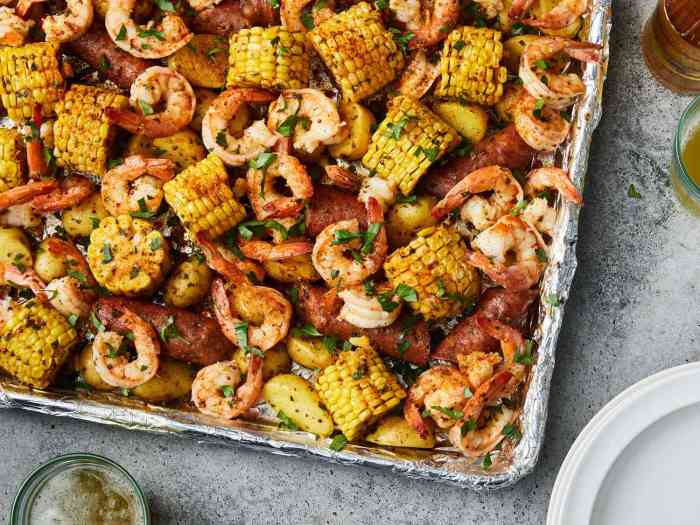
This mild shrimp boil is a versatile dish that can be adapted to your liking. You can experiment with different ingredients, flavors, and even dietary restrictions. This section explores some variations and substitutions to make this recipe your own.
Alternative Ingredients
Here are some alternative ingredients that can be used in a mild shrimp boil:
- Seafood: Instead of shrimp, you can use other seafood like crawfish, crab legs, mussels, or even fish fillets. For a more flavorful experience, consider using a combination of different seafood.
- Vegetables: In addition to corn and potatoes, you can include other vegetables like carrots, onions, celery, or even asparagus. Experiment with different combinations to create your own unique flavor profile.
- Sausages: Adding smoked sausage, kielbasa, or andouille sausage can enhance the flavor and add a smoky dimension to the boil.
- Herbs and Spices: Experiment with different herbs and spices like bay leaves, thyme, paprika, or garlic powder to customize the flavor of your boil. For a spicier version, consider adding cayenne pepper or hot sauce.
Dietary Restrictions and Preferences
The mild shrimp boil recipe can be adjusted to accommodate various dietary restrictions and preferences.
A mild shrimp boil is a classic summer meal, with the tender shrimp, sweet corn, and starchy red potatoes all simmering together in a flavorful broth. But for a truly unforgettable experience, consider adding a side of cream corn that’s cream corn like no other.
This recipe takes the classic dish to a whole new level, with its rich, creamy texture and burst of flavor. The combination of the creamy corn with the spicy shrimp boil is a taste sensation that will leave you wanting more.
- Gluten-free: Ensure that all ingredients, including the stock and seasonings, are gluten-free. Use gluten-free sausage or omit it altogether.
- Dairy-free: This recipe is naturally dairy-free. However, if using a pre-made stock, check the ingredients to ensure it doesn’t contain dairy products.
- Vegetarian: Omit the shrimp and sausage and focus on a flavorful vegetable boil. You can add additional vegetables like mushrooms, zucchini, or bell peppers.
- Low-sodium: Use low-sodium stock and reduce the amount of salt added to the boil. You can also experiment with herbs and spices to enhance the flavor without adding extra salt.
Flavor Profiles
The following table Artikels different flavor profiles and their corresponding ingredient adjustments:
| Flavor Profile | Ingredient Adjustments |
|---|---|
| Classic Cajun | Use Cajun seasoning, andouille sausage, and a combination of shrimp, crawfish, and potatoes. |
| Mediterranean | Add lemon juice, oregano, and feta cheese. Use mussels and clams instead of shrimp. |
| Spicy | Increase the amount of cayenne pepper or add hot sauce. Use spicy sausage and consider adding jalapeños or habanero peppers. |
| Asian-inspired | Use ginger, garlic, soy sauce, and sesame oil. Add bok choy, shiitake mushrooms, and tofu. |
Tips and Tricks
Mastering the art of the shrimp boil is all about achieving perfect results. Here are some tips and tricks to ensure your shrimp boil is a hit.
Ensuring Perfectly Cooked Shrimp
- Timing is Key:Shrimp cooks incredibly fast, so it’s crucial to add it to the boiling water towards the end of the cooking time. Overcooked shrimp becomes rubbery and loses its flavor.
- Don’t Overcrowd:Avoid overcrowding the pot, as this can lower the water temperature and prevent the shrimp from cooking evenly. Cook in batches if necessary.
- Test for Doneness:The best way to determine if your shrimp is cooked through is to check for a pink color and a firm texture. The shrimp should also curl up slightly.
Preventing Mushy Potatoes
- Start with Firm Potatoes:Choose potatoes that are firm and free of blemishes. Avoid using potatoes that are soft or have started to sprout.
- Don’t Overcook:Potatoes will continue to cook even after being removed from the boiling water. Be careful not to overcook them, as they will become mushy.
- Cold Water Bath:Immediately after removing the potatoes from the boiling water, plunge them into a bowl of ice water to stop the cooking process and maintain their firmness.
Storing Leftovers
- Refrigerate Promptly:Leftover shrimp boil should be refrigerated within two hours of cooking.
- Separate Components:To prevent the shrimp from becoming rubbery, it’s best to store the shrimp separately from the potatoes and corn.
- Reheat Carefully:When reheating, avoid overcooking the shrimp. You can reheat the shrimp and potatoes separately in a microwave or on the stovetop.
Health and Nutrition
A shrimp boil, despite its indulgent nature, can be a surprisingly nutritious meal. While it’s not exactly a diet food, it offers a good balance of protein, carbohydrates, and essential vitamins and minerals. Let’s delve into the nutritional breakdown of this flavorful dish and explore ways to make it even healthier.
Nutritional Value of a Shrimp Boil
A shrimp boil is a good source of protein, thanks to the shrimp. The potatoes provide carbohydrates for energy, while the corn adds fiber and vitamins. The broth itself is rich in electrolytes, making it a good choice for rehydration after a workout.
Here’s a more detailed breakdown of the nutritional value of a typical shrimp boil:
- Protein:Shrimp is an excellent source of lean protein, containing all nine essential amino acids. A 3-ounce serving of cooked shrimp provides about 15 grams of protein. Protein is essential for building and repairing tissues, producing enzymes and hormones, and maintaining a healthy immune system.
- Carbohydrates:Potatoes and corn provide complex carbohydrates, which are digested slowly and provide sustained energy. A medium potato contains about 25 grams of carbohydrates, while a cup of corn contains about 20 grams.
- Fiber:Corn is a good source of fiber, which helps regulate digestion and promotes satiety. Fiber also plays a role in lowering cholesterol levels and reducing the risk of heart disease.
- Vitamins and Minerals:Shrimp boil ingredients offer a range of essential vitamins and minerals, including vitamin C, potassium, iron, and zinc. These nutrients support various bodily functions, such as immune health, bone health, and energy production.
Health Benefits of Key Ingredients, Mild style shrimp boil with corn and red potatoes
Let’s look at the health benefits of some of the key ingredients in a shrimp boil:
- Shrimp:Besides being a great source of protein, shrimp is also rich in omega-3 fatty acids, which have been linked to heart health and brain function. Shrimp is also a good source of selenium, an antioxidant that protects cells from damage.
- Potatoes:Potatoes are a good source of vitamin C, potassium, and fiber. Potassium is an essential mineral that helps regulate blood pressure and muscle function. The fiber in potatoes helps promote digestive health and satiety.
- Corn:Corn is a good source of fiber, vitamin B6, and folate. Folate is essential for cell growth and development, and it plays a crucial role in preventing neural tube defects in babies.
Tips for Making a Shrimp Boil Healthier
While a shrimp boil can be a healthy meal, there are some ways to make it even healthier:
- Use low-sodium broth:The broth is a significant contributor to the sodium content of a shrimp boil. Using low-sodium broth can help reduce your sodium intake.
- Reduce the amount of butter:Butter is a source of saturated fat, which can increase cholesterol levels. Using less butter or substituting it with healthier fats, like olive oil, can make the dish healthier.
- Add more vegetables:Incorporate a variety of vegetables, such as carrots, onions, celery, and green beans, to add flavor and nutrients to the boil.
- Choose whole-grain corn:Whole-grain corn contains more fiber and nutrients than refined corn.
- Use fresh shrimp:Fresh shrimp is typically lower in sodium and preservatives than frozen shrimp.

